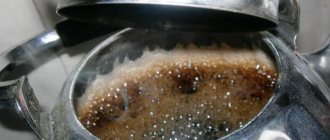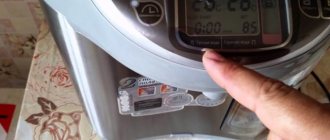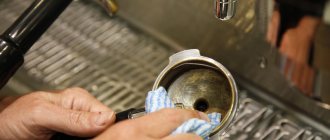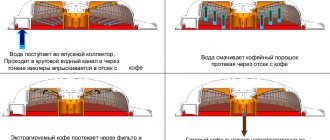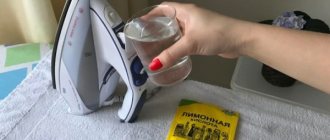When water boils, solid deposits appear inside the kettle, small particles of which even pass through the mesh and end up in the drink. And the view inside the kettle becomes unaesthetic. It will take very little time to get rid of this problem. In addition, every housewife probably has a life-saving remedy in her kitchen.
Find out how to clean a kettle even from old scale using ordinary table vinegar and enjoy a wonderful tea party!
Causes of scale and its harm
The cause of deposits on the walls of the kettle are the salts contained in the water. The most unpleasant for dishes are calcium compounds. When water is heated, calcium carbonates (CaCO3) and magnesium carbonates (MgCO3) are formed. They settle to the bottom, walls and heating elements of the kettle in the form of a rough yellow-gray coating, which is called scale.
The intensity of the appearance of deposits depends on the “hardness” of the water (the level of mineral salts in it) - the higher it is, the faster plaque forms.
Note! Scale not only spoils the appearance of the dishes, but also reduces heat transfer - it takes more time to bring water to a boil. If the inside of the kettle is “dressed in a fur coat” with a thickness of only 1 mm, heat costs will increase by 10%!
The damage caused by scale in electric kettles is especially noticeable. By settling on heating elements, deposits contribute to their rapid failure. As a result, expensive equipment breaks down without using up its full service life.
If you ignore the appearance of scale in the kettle and continue to boil water in it, soon tea drinking will cease to bring joy and pleasure. And all because, along with the water, gray flakes - particles of salt deposits - will begin to fall into the tea cup. This “additive” can ruin not only the appearance of the drink, but also its taste.
Today, there are many ways to completely purify drinking water. But it is the content of microelements in it that makes water “alive”, since they are necessary for the normal functioning of various organs and systems of the body.
There is only one way to preserve the beneficial properties of water and solve the problem of scale - timely cleaning of dishes.
How to descale a kettle with vinegar at home
Do you know that:
Stretch ceilings made of PVC film can withstand from 70 to 120 liters of water per 1 m2 of their area (depending on the size of the ceiling, the degree of its tension and the quality of the film). So you don’t have to worry about leaks from neighbors above.
Before removing various stains from clothing, you need to find out how safe the selected solvent is for the fabric itself. It is applied in a small amount to an inconspicuous area of the item from the inside out for 5-10 minutes. If the material retains its structure and color, you can move on to stains.
There are special traps to combat moths. The sticky layer with which they are covered contains female pheromones that attract males. By sticking to the trap, they are eliminated from the reproduction process, which leads to a decrease in the moth population.
The dishwasher cleans more than just plates and cups. You can load it with plastic toys, glass lamp shades and even dirty vegetables, such as potatoes, but only without using detergents.
The habit of using an automatic washing machine “sparingly” can lead to the appearance of an unpleasant odor in it. Washing at temperatures below 60℃ and short rinses allow fungi and bacteria from dirty clothes to remain on internal surfaces and actively multiply.
Fresh lemon is not only suitable for tea: clean dirt from the surface of an acrylic bath by rubbing with half a cut citrus, or quickly wash the microwave by placing a container of water and lemon slices in it for 8-10 minutes at maximum power. The softened dirt can simply be wiped off with a sponge.
If your favorite things show the first signs of gestation in the form of untidy pellets, you can get rid of them using a special machine - a shaver. It quickly and effectively shaves off clumps of fabric fibers and returns things to their proper appearance.
The easiest way to remove scale and carbon deposits from the soleplate of the iron is with table salt. Pour a thick layer of salt onto the paper, heat the iron to maximum and run the iron over the salt bed several times, applying light pressure.
Threads made of gold and silver, which were used to embroider clothes in the old days, are called gimp. To obtain them, the metal wire was pulled for a long time with pliers to the required fineness. This is where the expression “to drag out the rigmarole” came from - “to do long, monotonous work” or “to delay the completion of a task.”
Why is the use of vinegar so effective in the fight against scale?
Many cleaning products contain organic acids, aromatic additives and other chemical compounds. All this is included in the price of the product.
In fact, the basis of descaling is the reaction of splitting magnesium and calcium salts. Vinegar copes with this task without any problems, and in small concentrations - the most popular are 6% and 9%.
Another reason why descaling a kettle with table vinegar shows excellent results is the liquid state of the cleaning agent. It penetrates into all hard-to-reach places, removing salt deposits.
In addition, vinegar has other advantages over most limescale removers. Among the main ones:
- availability;
- efficiency;
- efficiency;
- relative safety;
- ease of use.
Note! When used in the correct concentration, acetic acid does not damage the inside of the kettle and is easily washed off after use.
Basic methods for cleaning a kettle with vinegar
There are several ways to use vinegar to descale dishes. Some of them are aimed at preventing the formation of scale, others at removing old deposits.
The proposed recipes call for the use of the most popular 9% table vinegar. It is sold in most grocery stores. You can also get a similar product by diluting 1 part vinegar essence with 7 parts water.
Important! When handling concentrated acid, safety rules must be followed!
Classic way
- Fill the kettle with cold water and add vinegar at the rate of 100 ml per liter.
- Boil water, leave for 2-3 hours, and if heavily soiled, leave overnight.
- Then pour out the contents and clean the inner surface with a sponge, easily removing any loose deposits.
- Rinse well, fill with clean water, boil and drain again.
The kettle is ready to use!
Cleaning process
Deposits on the walls of the kettle form salts, which react with acid (vinegar) and break down into soluble salts and carbon dioxide - this is information from a school chemistry textbook. From the same source you can learn that sodium bicarbonate is a soft alkali that acts as a leavening agent. When combining acid and alkali, the effect is enhanced and the scale is destroyed. Ready-made cleaning products, as a rule, consist of harmless acids, but they may well contain caustic components that leave stains on stainless steel and corrode the coating of the heating element of the electric kettle.
The main advantage of baking soda is its absolute safety and effectiveness. When heated, sodium bicarbonate decomposes at 60°C and does not contain harmful and caustic fumes.
The recipes may seem very simple, but they are so reliable that they can be called classics.
Every housewife knows the recipe for cleaning with soda.
Baking soda
With soda, which is sold in regular grocery stores, you can clean any dishes - enameled, stainless or plastic with a heating element.
- Pour water to 2/3 volume.
- Add three tablespoons of baking soda.
- Boil for about half an hour.
- Leave for one hour.
- Wash off the loosened plaque.
A small layer of scale will easily come off after this simple procedure, but a thick layer of limescale will hardly be removed. In difficult cases, the kettle will have to be descaled with soda and organic acid, which will enhance the effect.
Soda with vinegar
To free a kettle from a thick layer of limescale at home with vinegar and soda, you will need 9 percent or diluted vinegar essence 70. The rust will be washed off along with the solid sediment.
- Pour half a glass of 9 percent vinegar into the kettle.
- Add a large spoonful of baking soda.
- When the reaction is complete, add water.
- Boil for half an hour.
If scale persists, you can use a more complex step-by-step method:
- Add three tablespoons of baking soda to boiling water.
- Remove from heat for half an hour. Repeat boiling.
- Rinse. Fill again, pour in half a tablespoon of vinegar essence. Boil for half an hour.
- Rinse the dishes and rub with a hard mesh - the loose layer will be easily cleaned off.
In this way, even old scale can be removed - it will be removed in layers.
Attention! You cannot clean plastic electric kettles from scale with vinegar essence. In this case, citric acid or vinegar will do.
A mixture of soda and vinegar is suitable if you do not know how to clean a thermos of tea deposits. The baking soda solution will loosen stains, and the vinegar will remove odors. Just add 2-3 teaspoons of vinegar and soda to a thermos and pour boiling water over it for a couple of hours.
Soda with citric acid
Citric acid in combination with soda is suitable for electric and regular kettles.
Citric acid in combination with soda is suitable for electric and regular kettles
- Pour water.
- Add two teaspoons of citric acid and soda for each liter.
- Heat and let simmer for 15-20 minutes.
- Remove from heat and leave to cool with the acid-base solution.
- Pour it out. Repeat everything again.
- Rub the scale with a hard mesh, wash, fill with clean water and boil.
Soda and salt
This combination allows you to free the kettle from deposits of hard limescale deposits.
- Pour a tablespoon of salt and two tablespoons of soda into a full kettle.
- Boil for 10-15 minutes.
- Leave the solution to cool in the container.
- Wash the inside surface.
The procedure can be repeated if scale residues are visible.
Soda Ash
Sodium carbonate is an aggressive alkali that easily dissolves a dense layer of limescale deposits.
- Dissolve a tablespoon of powder in a small volume of water.
- Boil a liter of water in a kettle.
- Pour the solution into boiling water and remove the kettle from the heat.
- After cooling, wash off the plaque with a sponge - it will peel off easily.
- Rinse the dishes in a large volume of water, fill and boil well to remove any remaining alkali.
Carefully! You need to wear rubber gloves when working with alkali. Do not inhale steam when boiling and try to carefully pour the powder so that it does not damage the mucous membrane of the nose and larynx.
How to choose the right method?
The models of modern teapots are varied: metal, glass, plastic. But they are all susceptible to scale formation and require regular or preventative cleaning.
Which method will be optimal for a particular type?
Electrical
If the electric kettle has a plastic body surface and a slight layer of scale, use the classic method without leaving the vinegar solution overnight.
Due to the fact that the heat-resistant polymers from which the bodies of electric kettles are made are resistant to solutions of acetic acid and baking soda, in some cases it is possible to use step-by-step cleaning.
Important! Using too much acetic acid solutions may damage the plastic surface and heating elements.
Glass
Glass-bodied teapots are filled with water, vinegar is added, boiled and left for 2-3 hours. Remaining scale is cleaned with a sponge. In case of persistent contamination, the procedure is repeated.
Stainless steel
Using vinegar, you can easily descale stainless steel kettles.
To do this, first pour in a soda solution and let it sit for a while. Then wipe the surface with a cloth or napkin soaked in a weak solution of acetic acid.
By the way, this method will allow you to clean the dishes not only inside, but also from the outside - from grease.
Brewing
Pour water into a fairly large saucepan, heat to a boil, remove from heat. Add vinegar and baking soda.
Carefully lower the teapot into the foaming solution, cover the pan with a lid, and leave for 30 minutes. This is enough to remove all plaque, including from the narrow nose.
Finally, rinse the kettle thoroughly.
We recommend reading: Vinegar and soda for cleaning pipes: 3 most effective methods
Enameled
The most traditional attribute in the kitchen requires careful handling. An attempt to remove scale mechanically leads to damage to the enamel and the appearance of corrosion. The water in such dishes is contaminated with heavy metal compounds, which are extremely harmful to health. Vinegar is ideal for removing scale from enamel containers. Any method can be used.
Note! It is better to pour cold water into a kettle that has already cooled down so that the enamel coating does not crack and lose its appearance.
A little about prevention
Using vinegar to remove scale, you don’t have to worry about the problem of lime deposits. It is enough to follow simple rules:
- Before each use, rinse the kettle and add the required amount of fresh water to avoid repeated boiling.
- Clean the inner surface once a month, even if the sediment is insignificant.
- Use soft filtered water.
Additional information: When cleaning salt deposits with vinegar, persistent unpleasant odors are simultaneously removed.
Thanks to regular descaling using vinegar solutions, the kettle will look “like new” for a long time and its service life will be extended. After boiling, water does not lose its beneficial properties, maintaining the taste of hot drinks.
Cleaning the electric kettle
A kitchen appliance that has large deposits of stone in it not only looks terrible, but the water in it also takes longer to boil because the scale retains the heat generated and therefore uses more energy. To descale your kettle with vinegar for optimal performance, you must:
- Fill the container to half or three-quarters level with equal amounts of water and vinegar.
- Boil. After turning off, unplug the power cord from the grille.
- Leave the mixture in the device for half an hour. Drain the liquid and rinse the inside of the container. You can rinse it a few times to make sure there are no traces of vinegar left in the kettle.
- Wipe the inner surface with a clean cloth and leave until completely dry.
- You can then boil clean water again and pour it down the sink to remove any possible lingering aftertaste from cleaning.
- If the smell of vinegar remains, boil the water several times. For severe deposits, you can use a more concentrated solution and leave it overnight.
Descaling can be done using baking soda and vinegar - half a glass of baking soda and three tablespoons of vinegar per kettle. Mix the ingredients, dilute with water and pour into a vessel, boil the mixture and let stand for an hour. Pour out the liquid, if necessary, treat the inner surface of the container and remove any remaining scale.
